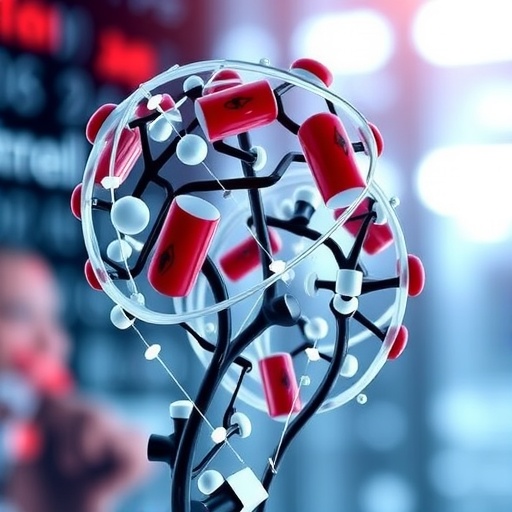
The pharmaceutical industry is undergoing a profound transformation as artificial intelligence, particularly large language models (LLMs), begins to redefine the very fabric of drug development. These advanced AI architectures, which underpin next-generation chatbots, are proving to be more than just computational tools; they are becoming pivotal collaborators in accelerating and enhancing drug discovery and development. The latest insights from a group of Chinese researchers, published in the KeAi journal Current Molecular Pharmacology, reveal how LLMs are revolutionizing multiple facets of the pharmaceutical pipeline, from early drug target identification to the nuanced challenges of clinical trial management.
At the heart of this revolution is the ability of large language models to process and interpret extraordinarily complex biological and chemical data with near-human cognitive fluency. Unlike traditional computational methods that rely heavily on rule-based algorithms or limited datasets, LLMs leverage vast corpora of biomedical literature, molecular databases, and clinical records. This capability empowers them to identify novel drug candidates that might have otherwise gone unnoticed amid the vastness of chemical and protein interaction spaces. Dr. Anqi Lin, a key author of the study, emphasizes that these models deliver a “quantum leap” in pharmaceutical innovation by uncovering hidden correlations and generating hypotheses at unprecedented speeds.
One of the most promising applications of LLMs lies in the initial stages of drug discovery—target identification and drug screening. Utilizing specialized protein-focused language models such as GPCR LLMs and ProtChat, researchers now integrate 3D structural data of proteins with interaction predictions, vastly improving the reliability of identifying viable drug targets. These advanced models effectively forecast drug-target interactions, enabling high-throughput virtual screening of compounds that could modulate specific biological pathways. This approach not only expedites the identification process but significantly reduces the financial and temporal burdens conventionally associated with experimental screening.
.adsslot_0svtzrxiCc{width:728px !important;height:90px !important;}
@media(max-width:1199px){ .adsslot_0svtzrxiCc{width:468px !important;height:60px !important;}
}
@media(max-width:767px){ .adsslot_0svtzrxiCc{width:320px !important;height:50px !important;}
}
ADVERTISEMENT
Beyond target identification, LLMs are redefining drug molecular design and optimization. Models like 3DSMILES-GPT and FragGPT offer a leap forward in generating and refining molecular structures with optimized pharmacological properties. These systems employ sophisticated natural language processing techniques to encode molecular graphs and chemical syntax, allowing them to propose novel molecules with enhanced efficacy, stability, and bioavailability. In parallel, platforms such as DrugAssist utilize these models to fine-tune molecular candidates, optimizing them iteratively to improve therapeutic performance while minimizing adverse effects.
Drug repurposing, a strategy aimed at identifying new therapeutic uses for existing medications, has also been transformed by the integration of LLMs like ChatGPT and DrugReAlign. By analyzing vast datasets encompassing clinical trial results, biochemical properties, and real-world patient outcomes, these models can efficiently pinpoint drugs with latent potential against diseases beyond their original indications. This capability promises to shorten drug development timelines dramatically and reduce associated costs, providing faster relief for patients in need of urgently deployable therapies.
Preclinical research, historically one of the most labor-intensive phases of drug development, benefits immensely from LLM-powered predictive analytics. Advanced models including GPT-4, CancerGPT, and LEDAP exhibit exceptional proficiency in simulating and forecasting a compound’s pharmacokinetic properties, toxicity profiles, and drug-drug interactions. Through in silico experimentation, these tools enhance the accuracy and scope of preclinical assessments, allowing researchers to anticipate adverse effects before costly and time-consuming lab tests or animal studies. The integration of these models accelerates safety evaluation and informs rational decision-making at critical junctures.
Clinical trials, the final and most complex stage in drug development, present enormous data handling challenges due to their scale and regulatory scrutiny. LLMs such as SEETrial have been developed to support clinical decision-making by extracting and synthesizing relevant data from electronic health records, trial protocols, and outcome measurements. Their ability to detect subtle patterns and correlations assists in refining patient selection, monitoring safety signals in real-time, and predicting trial endpoints. The automation and enhanced insight gained through these models promise to reduce trial costs, improve patient safety, and ultimately facilitate the approval process.
Despite these breakthroughs, the deployment of LLMs in drug development is not without significant obstacles. One pressing issue is the scarcity of high-quality, comprehensive datasets essential for training and validating these models. Biomedical data often suffer from fragmentation, proprietary restrictions, and variability across populations, which impairs model generalizability. Moreover, the computational demands of training and fine-tuning large language models remain formidable, requiring substantial infrastructure investments. These factors collectively limit the widespread, democratized application of LLMs at present.
Additionally, the inherent complexity of AI decision-making and its “black-box” nature present challenges for interpretability and trust in clinical contexts. Ensuring algorithmic transparency and enabling explainability are crucial for gaining the confidence of regulatory bodies, clinicians, and patients. Ethical considerations surrounding patient privacy, data security, and bias mitigation remain central concerns as these models increasingly interact with sensitive health information. Addressing these issues will necessitate continual multidisciplinary collaboration among AI experts, pharmacologists, ethicists, and healthcare providers.
Looking forward, the researchers underscore a vision of synergistic partnerships between human expertise and artificial intelligence. Rather than viewing LLMs as replacements for human researchers, the optimal trajectory involves coalescing human intuition with AI-driven insights to tackle medicine’s most persistent challenges. Future research directions emphasize enhancing LLMs’ cross-modal learning capabilities to integrate diverse biochemical data types and experimental modalities. Moreover, developing specialized interfaces to seamlessly embed LLMs alongside biochemical analysis tools and laboratory workflows is anticipated to maximize practical utility.
Refinements in fine-tuning methodologies also represent a critical frontier. Tailoring base language models to specific subdomains of pharmacology or particular diseases can amplify accuracy and relevance. Equally important is the establishment of robust validation frameworks to rigorously assess prediction reliability, safety, and reproducibility. These efforts are fundamental not only to advancing scientific understanding but also to fulfilling regulatory requirements that ensure patient protection.
In sum, the infusion of large language models into drug development constitutes a paradigm shift with vast implications. Their capacity to decode intricate biological languages, generate innovative molecular designs, and streamline clinical evaluations promises to accelerate the delivery of effective therapies. While challenges persist, the convergence of AI advancements and pharmaceutical science heralds a new era of collaborative intelligence where machine learning augments human ingenuity in the pursuit of improved global health outcomes. As Dr. Peng Luo eloquently concludes, fostering this alliance between humans and LLMs will pave the way for transformative breakthroughs in medicine.
Subject of Research: Not applicable
Article Title: Applications of Large Language Models in Drug Development
News Publication Date: Not specified
Web References: http://dx.doi.org/10.1016/j.cmp.2025.06.003
References: Not specified
Image Credits: Anqi Lin, Xiuhui Fang, Aimin Jiang, Chang Qi, Wenyi Gan, Lingxuan Zhu, Weiming Mou, Dongqiang Zeng, Mingjia Xiao, Guangdi Chu, Shengkun Peng, Hank Z.H. Wong, Lin Zhang, Hengguo Zhang, Xinpei Deng, Quan Cheng, Haoran Zhang, Zhuocheng Zhong, Zhengrui Li, Bufu Tang, and Peng Luo
Keywords: Health and medicine
Tags: accelerating drug discovery with AIadvancements in drug target identificationAI collaboration in pharmaceutical innovationAI-driven clinical trial managementartificial intelligence in pharmaceuticalscomputational tools in medicinedata processing in drug developmentlarge language models in drug developmentmachine learning in biomedical researchnovel drug candidate identificationrevolutionizing clinical trials with technologytransforming pharmaceutical research with AI





